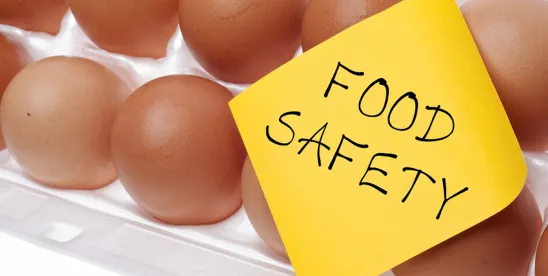What You Need to Know in a Minute or Less
Until recently, state regulators largely deferred to the US Food and Drug Administration (FDA) to scrutinize and regulate contaminants in food, such as heavy metals. In the past several years, however, states have taken an increasingly active role in regulating foods, not only from the standpoint of what can be added to food (e.g., California’s 2023 food additive ban and a broader, more impactful 2025 additive ban in West Virginia) but also from the standpoint of unwanted contaminants in food.
This edition of Litigation Minute discusses some recent state laws and introduced bills that could provide fodder to class action plaintiffs to argue that foods are, for example, labeled in a false or misleading way or unsuitable for their intended use. In a minute or less, here is what you need to know about state laws on contaminants in food.
What Contaminants Are States Targeting?
To provide a sense of the types of laws emerging at the state level on contaminants in food, consider the following examples:
- AB 899 in California and Rudy’s Law in Maryland require baby food companies to test every lot of baby food for heavy metals and publish the results on that testing on their website.
- New York state has proposed action levels for heavy metals in spices of 0.21 parts per million (ppm) lead, 0.26 ppm cadmium, and 0.21 ppm inorganic arsenic.
- Proposed legislation known as LD 130 in Maine would establish maximum levels for perfluoroalkyl and polyfluoroalkyl substances (together, PFAS) in agricultural products.
- According to Safer States, 19 states have passed 43 laws affecting substances used in food-contact materials (e.g., bisphenols, PFAS, ortho-phthalates, polystyrene); many of these laws have the aim of preventing these substances from becoming contaminants in food, as well as include goals that are environmentally focused.
How Did We Get Here?
Many of these state laws have been implemented in response to events like the WanaBana applesauce recall for lead, articles noting concerns regarding heavy metals in food in the popular press (e.g., Consumer Reports), blog postings, and social media activity.
The state laws also seek to fill a perceived void where FDA has not taken action or where its compliance with administrative procedure has led to an arguably slow response. For example, FDA initiated its Closer to Zero initiative in 2021 to identify ways to reduce exposure to heavy metals in food consumed by babies and young children. However, as of 1 May 2025, the only action level to have been finalized was lead in certain baby foods (i.e., fruit and vegetable purees, infant cereal, yogurt). FDA had planned on starting the process of setting action levels of arsenic and cadmium in 2025; however, that was prior to workforce reductions recommended by the current administration. It is not clear whether FDA will move forward on these initiatives in 2025. It is possible that continued lack of action at the FDA level will lead to more state laws in the future.
Many of these new state laws seem to have drawn some inspiration from California’s Safe Drinking Water and Toxic Enforcement Act of 1986, popularly known as Proposition 65. Proposition 65 until now had been a unique right-to-know law requiring that a company warn a consumer before exposing them to one of approximately 1,000 listed carcinogens or reproductive toxicants. However, states are now considering legislation similar to Proposition 65. For example, Missouri is currently considering a bill (HB 260) that would require warnings if certain contaminants (e.g., lead, cadmium) or FDA-approved color additives (e.g., Red 40) are in the product. Similarly, Texas has passed a law (SB 25) requiring warnings when certain ingredients (e.g., bleached flour), food additives (e.g., artificial sweeteners), or color additives are used in foods; the Texas law does not require warnings for contaminants.
Impact of State Laws on Litigation Risk
These state laws present plaintiffs with potential avenues for pursuing litigation. With respect to the AB 899 and Rudy’s Law disclosures for baby food, the publication of heavy metal test information could lead to challenges based on Proposition 65 in California. There are also examples of plaintiffs alleging that the presence of such contaminants conflicts with claims like “natural” or health-related claims. One of the earlier examples of this type of lawsuit was Doss v. General Mills, Inc., No. 19-12714 (11th Cir. May 20, 2020), in which the plaintiff alleged that claims like “packed with nutrients” and “wholesome” on Cheerios were rendered misleading by residues of glyphosate that were in compliance with federal law. Similarly, the New York proposed action limits on heavy metals in spices could be a basis for alleging that any spice exceeding those levels render the spices unsuitable for use in food. Class actions following recalls are fairly common.1
Takeaways
States’ increased activity in regulating food provides additional fodder for private plaintiffs seeking to challenge the labeling and safety of foods based on the presence of low levels of contaminants. These laws unfortunately give credence to the position that there is cause for concern, even when exposures are very low and present at levels consistent with Current Good Manufacturing Practices (i.e., industry best practices for producing safe and high-quality foods).
The next edition in this Litigation Minute series will focus on examples of class action litigation targeting contaminants, including a recent case trying and failing to allege that chocolate violated various state unfair business practices and similar laws due to the presence of heavy metals.
Footnotes
1 See, e.g., Willis v. Thomson Int’l Inc., 37-2020-00027164-CU-PL-CTL (Cal. Cnty. Ct. 2020) (filed after a Listeria monocytogenes recall on onions).
- Also see websites like TopClassActions.com, which closely monitors product recalls with the expectation that recalls could evolve into class action litigation.






 />i
/>i

